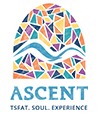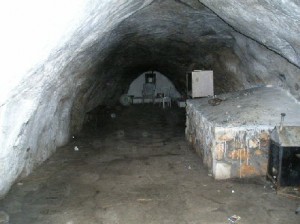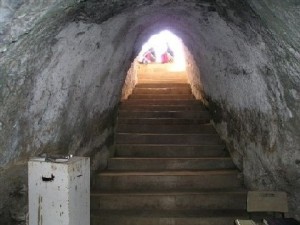…PAIRED IN LIFE, AND BEYOND…
by Chana Katz
They were one of history’s most famous pairs, noted, of all things, for their intense arguments with one another! But in the end they were inseparable. They were buried together in one of the most elevated and scenic sites in northern Israel, where, on a clear day, you could almost see forever.
Abbaye and Rava, as they were known, lit the study halls in ancient Babylonia with their fiery Torah debates, ensuring their niche among the most quoted sparring partners in the Talmudic period known as the Amoraim (explainers or interpreters), from about 200-500 CE.
What’s so great about always arguing? one might ask. It says in Ethics of Our Fathers (Pirkei Avot) that a controversy which is for the sake of heaven, such as that of Hillel and Shammai, will endure, whereas arguments that are not for the sake of heaven in the end will not endure.
Those of Abbaye and Rava did endure and many of the discussions between the two were preserved in the Babylonian Talmud. Today one can enter the study hall of even young children learning Torah and see them waving their thumb in a clockwise motion saying, “….Abbaye said….”
Although both Abbaye and Rava introduced the Torah student to noted points of view, still, a final decision must be made when it comes to halacha, or Jewish law, and it is said that in all but six instances the halacha was based on Rava’s interpretations. But in the end it was Abbaye, who was engaged in acts of good deeds as well as Torah study, who outlived his colleague by 20 years.
* * *
Abbaye and Rava were among the many bright spots in what started out as a dismal and bitter exile from Eretz Yisroel to Babylonia, a period which spanned some 1,500 years. When the Babylonians captured 10,000 Jews from Israel and took them from the Holy Land, it didn’t look like a very bright future for the Jewish nation. But as it turned out, these initial 10,000 captive Jewish souls actually planted the seeds for what was to become the greatest center of Torah learning in its time, culminating with the rendering of the Babylonian Talmud.
Abbaye, who was also known as Nahmani ben Keilil, lost his father before he was born and then his mother died upon his birth. He grew up in the home of his uncle, the famous Torah sage, Rabbah. Upon the death of Rav Yosef, Abbaye was chosen from among four candidates (including Rava) to head the prestigious learning academy at Pumbedita.
Both Abbaye and Rava are recorded as having descended from the famous house of Eli, the high priest and mentor of Samuel the Prophet.
Rava, who opened a school in Mahoza on the banks of the Tigris, was said to have been very poor and cultivated his vegetable plot by night in order to be able to learn by day.
One of Abbaye’s most notable halachic opinions is one in which he permitted the Hebrew language to be used in all matters and places, in opposition to those who sought to preserve it for only sacred places and activities.
By now, one must be wondering what a discussion between Abbaye and Rava sounded like. Since they are probably the most quoted partners in the Talmud, finding such an example is not so difficult, such as this one brief example found in Tractate Nedarim, p. 39b:
“It was taught: There is no measure for visiting the sick. What does ‘no measure’ mean?
Rabbi Yosef explained: This means the rewards for doing so are unlimited.
But Abbaye said: Is there a definitive measure of reward for carrying out any commandment? … Rather, ‘no measure’ means that even a great person must visit a lowly one who is sick.
Rava said: A person must visit the sick even a hundred times a day.”
* * *
Now that some of us know a little more about Abbaye and Rava, the fun begins. Getting to their burial site from Tsfat is one of the most beautiful local outings and the clearer, the crisper the day, the more invigorating the experience and more splendid the view!
To get there from Tsfat, head out of the city toward the Haifa-Acco Road but don’t turn left there, instead head straight up the hill in the direction of the Bat Ya’ar Ranch and Amuka. The Biriya Forest will be ahead but you will want to make a right turn first at a sign that says Biriya Watchtower and Fort Biriya. You will see a cement barricade which leads into an army base. Before that you will see a sign in Hebrew: kever Abbaye & Rava, 0.8 kilometer.
There you will take a left off the paved road onto a rocky path. You will soon find yourself in the midst of a lovely, peaceful forest. Then, in an almost roller-coaster setting, you will drive up a very steep slope but it will level off faster than you’d think and more radar stations (pointing in the direction of Syria) will be visible and a sign that says Yavnit Mount.
To the left you have already come to a clearing and what a view! Even on a hazy day you can still make out the outline of Israel’s largest mountain in the distance, Har Hermon. You can take the car all the way to the entrance of the kever but the rocky road is narrow, so you may want to park and walk the remaining short distance listening to the whoosh of the wind and the stones grinding under your shoes on the sandy path.
There it is, a white cement canopied pavilion with a blue dome and a sign in Hebrew saying Abbaye and Rava. (Directly right above it is the kever of R. Yehuda Nasiya, the great-grandson of R. Yehuda haNasi).
This burial cave is unlike many others in the northern Galilee in that one does not have to crouch down to get inside. Walk down 76 modern steps and you will pass under an arched corridor. Another 14 steps and you will get a strong whiff of the earthy cave smell. There’s green moss on the walls and a fly buzzing by, its simple noise reverberating in the outer tunnel. Inside, a stone floor covers the usual dirt and rock bottom found in similar caves.
And until a large jeep pulls up to exit with a tour guide and a group of visitors, you are alone with Abbaye and Rava, a very large tzedoko (charity) box and a table filled with prayer books and Tehillim.
Although the sun’s heat is getting stronger outside, nature’s air conditioner provides comfort in this cave, where one can only wonder what Abbaye and Rava are learning today in the heavenly academies. Are they partners there, too? What magnificent Torah truth and purity are they beholding as one?
Buy guidebooks to Safed and the Galilee at the Kabbala Online Shop.
Chana Katz, a former South FLorida journalist, lives in Tsfat. Her articles on life in Israel have reached publications throughout the world.


